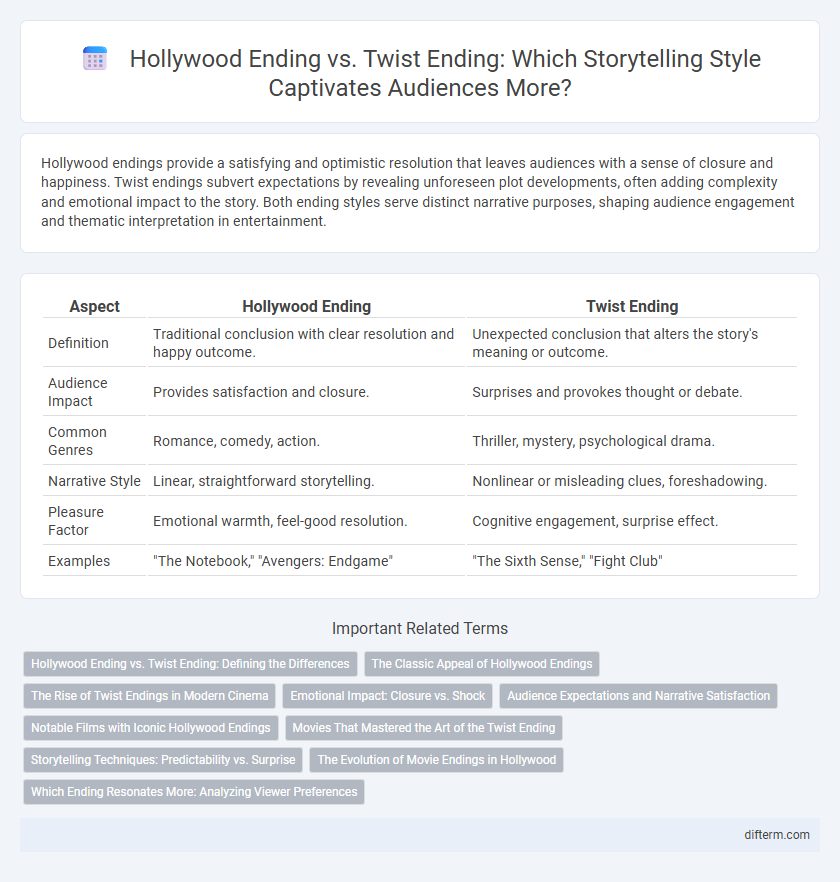Hollywood endings provide a satisfying and optimistic resolution that leaves audiences with a sense of closure and happiness. Twist endings subvert expectations by revealing unforeseen plot developments, often adding complexity and emotional impact to the story. Both ending styles serve distinct narrative purposes, shaping audience engagement and thematic interpretation in entertainment.
Table of Comparison
| Aspect | Hollywood Ending | Twist Ending |
|---|---|---|
| Definition | Traditional conclusion with clear resolution and happy outcome. | Unexpected conclusion that alters the story's meaning or outcome. |
| Audience Impact | Provides satisfaction and closure. | Surprises and provokes thought or debate. |
| Common Genres | Romance, comedy, action. | Thriller, mystery, psychological drama. |
| Narrative Style | Linear, straightforward storytelling. | Nonlinear or misleading clues, foreshadowing. |
| Pleasure Factor | Emotional warmth, feel-good resolution. | Cognitive engagement, surprise effect. |
| Examples | "The Notebook," "Avengers: Endgame" | "The Sixth Sense," "Fight Club" |
Hollywood Ending vs. Twist Ending: Defining the Differences
Hollywood endings typically deliver a satisfying, conclusive resolution where protagonists achieve their goals, reflecting a traditional narrative closure. Twist endings subvert audience expectations with unforeseen plot reversals that challenge prior assumptions and add complexity to the story. While Hollywood endings emphasize emotional fulfillment, twist endings prioritize shock value and narrative innovation to keep viewers engaged.
The Classic Appeal of Hollywood Endings
Hollywood endings captivate audiences with their clear resolution, often featuring protagonists overcoming obstacles and achieving happiness, ensuring emotional satisfaction. This classic appeal draws viewers by delivering a predictable yet comforting conclusion, reinforcing familiar narrative structures and moral clarity. In contrast to twist endings that subvert expectations, Hollywood endings maintain a sense of closure that aligns with traditional storytelling values.
The Rise of Twist Endings in Modern Cinema
The rise of twist endings in modern cinema has transformed Hollywood storytelling by subverting audience expectations and enhancing narrative complexity. Films like "Gone Girl" and "Shutter Island" leverage unexpected plot reversals to create memorable, discussion-worthy conclusions that boost viewer engagement and box office success. This shift reflects a growing preference for psychologically intricate and unpredictable story arcs over traditional Hollywood endings.
Emotional Impact: Closure vs. Shock
Hollywood endings provide emotional closure by resolving character arcs and plotlines, offering audiences a sense of satisfaction and finality. Twist endings trigger shock and surprise by abruptly altering the story's direction, evoking strong emotional reactions like disbelief or excitement. The choice between closure and shock significantly influences the viewer's lasting emotional experience and overall reception of the film.
Audience Expectations and Narrative Satisfaction
Hollywood endings typically fulfill audience expectations by delivering clear, positive resolutions that ensure narrative satisfaction through closure and emotional payoff. Twist endings subvert these expectations, introducing unexpected plot revelations that challenge viewers' assumptions and provoke deeper engagement with the story. Both ending styles shape audience experience, balancing predictability and surprise to maximize impact and entertainment value.
Notable Films with Iconic Hollywood Endings
Notable films with iconic Hollywood endings include "Casablanca," where the protagonist's selfless choice highlights classic happy resolution themes, and "It's a Wonderful Life," which concludes with a heartwarming redemption affirming traditional values. These endings emphasize closure, emotional satisfaction, and often a moral lesson, contrasting with twist endings that typically subvert expectations as seen in films like "The Sixth Sense" or "Fight Club." Hollywood endings have become a defining characteristic of mainstream cinema storytelling, blending narrative predictability with audience comfort.
Movies That Mastered the Art of the Twist Ending
Movies that mastered the art of the twist ending, such as *The Sixth Sense* and *Fight Club*, leverage unexpected plot reversals to redefine the entire narrative, leaving audiences stunned. Unlike traditional Hollywood endings that offer clear resolution and closure, twist endings challenge viewers' perceptions by revealing hidden truths or altering the storyline's meaning at the climax. This storytelling technique enhances re-watchability and deepens thematic complexity, making films iconic in the entertainment industry.
Storytelling Techniques: Predictability vs. Surprise
Hollywood endings typically offer predictable resolutions that satisfy audience expectations through clear-cut triumphs or romances. Twist endings defy predictability by introducing unexpected plot developments that reframe the narrative, heightening emotional impact and engagement. Both storytelling techniques leverage viewer anticipation differently to balance comfort with surprise.
The Evolution of Movie Endings in Hollywood
Hollywood endings traditionally emphasize a clear resolution and happy conclusion, reflecting classic narrative structures that satisfy mainstream audiences. Twist endings, emerging prominently in the late 20th century, challenge viewer expectations by introducing unexpected developments that redefine the story's meaning. This evolution highlights Hollywood's shift towards complex storytelling, engaging viewers through ambiguity and surprise.
Which Ending Resonates More: Analyzing Viewer Preferences
Hollywood endings typically offer a satisfying resolution that aligns with audience expectations, often providing closure and emotional payoff. Twist endings challenge viewers with unexpected revelations, creating a lasting impact that stimulates discussion and rewatch value. Studies indicate that while Hollywood endings appeal to those seeking comfort and predictability, twist endings resonate more with audiences valuing surprise and complexity, showing a growing preference for narratives that provoke thought and engagement.
hollywood ending vs twist ending Infographic

 difterm.com
difterm.com